Bugs on Pansy
I talked about pest management on poinsettias and mums in the past. You know which crop I haven’t talked about? Pansy. I like pansies. I like how they give colors to an otherwise gray winter. This is a good time to chat about pansies. Propagators, such as Wagners (where I visited a few weeks ago), have been busy sending out their wonderful pansy plugs to many growers throughout the country.
So let’s chat about pansies and give you a list of pest and disease problems you might see on pansies this fall and next spring. I’m going to be brief about management because I don’t want to make this a 10,000-word newsletter. So feel free to reach out to your favorite entomologists, pathologists and horticulturists working for extension, manufacturers or dealers for more information about management.
Lots of bugs will feed on pansies in the landscape, but I must think hard to come up with a list of insects that might be problematic for pansies in greenhouses. Aphids, fungus gnats and shore flies are the most common pests. This is understandable because aphids are cool-season pests and fungus gnats and shore flies thrive in wet media. And guess what we have in the greenhouses during fall and early spring? Cooler temperatures, higher humidity and cloudy days contribute to making conditions optimal for aphids, fungus gnats and shore flies.
Drenches with systemic insecticides can be quite effective in preventing or eliminating aphid infestation. Most insecticides registered for aphid management are effective when sprayed. The key to managing aphids successfully is finding the infestation and treating it early. That means you’ll have to flip over low-laying leaves often to find the aphids, which love to feed on the underside of lower leaves. For fungus gnats and shore flies, moisture management is the key to preventing infestation.
Spraying for adult fungus gnats are usually not effective in resolving the problem, so I usually recommend drenching or sprenching the media with the nematode Steinernema feltiae (Nemasys) or azadirachtin (Azatin, Ornazin, etc.), pyriproxyfen (Distance or Fulcrum), s-kinoprene (Enstar), cyromazine (Citation) or diflubenzuron (Adept).
Infestations of thrips, whiteflies, spider mites, snails or slugs may pop up occasionally during the later part of the production cycle. Also, y’all may have come across articles that say fritillary caterpillars or pansyworm can be a problem for pansy. I’d only seen one case of that when I was a graduate student in the late 1990s. Never since then. That’s not to say that caterpillars can’t be a problem because I’ve seen a couple of cases of armyworms feeding on pansies. I categorize caterpillars as occasional pests. There are a lot of effective insecticides available to control caterpillars.
Did I miss anything? If I did, email me.

Diseases on Pansy
While I have a hard time thinking about super-serious pests of pansies in production, I have no problem making a long list of diseases that can cause quite a bit of problem for pansies. It seems like every plant disease in this world can infect pansies!
The first thing to do before y’all reach for the nearest fungicide is to diagnose the problem. Some cultural issues, such as nutrient deficiency or toxicity, suboptimal environmental conditions (especially extremely high temperature and humidity) and even a plant growth regulator at the wrong dose can create symptoms that are somewhat similar to the symptoms of diseases. Correct diagnosis will help you select the best management approach.
Root and crown rots, and damping off can wipe out a pansy crop quickly, so keep a close eye for anything that doesn’t look right (wilting, decline or simply collapsing) and diagnose the problem quickly. Pythium, Phytophthora, Rhizoctonia, Fusarium and black root rot can all cause serious problems.
The one common threat that links all these root diseases together is wet media from over-watering or poor drainage, so a major step in disease prevention is to watch the weather and irrigate carefully. Over-fertilization and improper pH levels can stress roots and provide pathogens the opportunity to invade.
For example, you can prevent black root rot by avoiding ammonium nitrogen and maintaining pH between 5.5 and 6. Drenching with a fungicide is an effective way of preventing or suppressing root rot and damping off. Some southern growers start fungicide drenches as early as the first week after transplant.
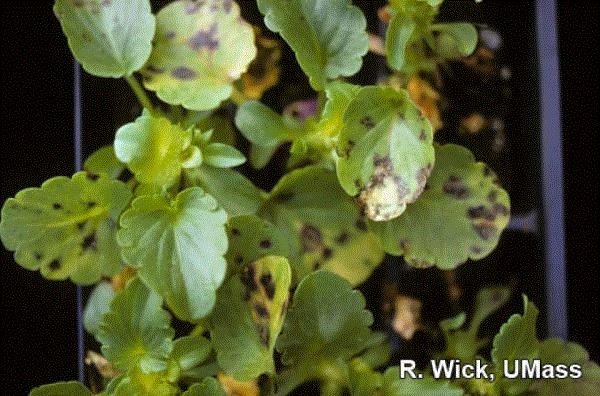
Cercospora leaf spot on pansy. (Photo credit: Robert Wick, University of Massachusetts.)
Leaf spots and Anthracnose are major issues for the leaves and flowers. I’ve seen or heard about Cercospora and Alternaria leaf spot more frequently than leaf spots by other fungi. Powdery mildew, downy mildew, rust and scab can occur occasionally and cause serious problems. Botrytis is common, especially in the latter part of the crop when there are lots of senescing flowers and leaves. These foliar diseases are particularly troublesome during an extended period of warm, cloudy and humid weather.
Sanitation before, during and after the crop is critical for managing these foliar diseases. Lots of folks find it bothersome to clean up senescing flowers and leaves or pull-out diseased plants, but that’s an effective way of preventing outbreaks of Botrytis and other foliar diseases. Also, avoid wetting the foliage during watering and crowding the plants to help reduce humidity and prevent diseases. Fungicide application is best applied as preventive. There are lots of fungicide options; talk to your favorite pathologists and select the best options for your operation.
There have been reports of Cucumber Mosaic Virus, which is vectored by aphids, on pansy. Cucumber Mosaic Virus is one of the major reasons why I don’t grow cucumbers in my garden anymore. I haven’t seen or heard about this virus on pansy for a while, so I’m not sure how important this disease remains for pansy crops.

BioWorks Introduces EpiShield
EpiShield—which contains peppermint oil, clove oil and sodium lauryl sulfate—is a new miticide and insecticide from BioWorks. Since it contains multiple essential oils, EpiShield has multiple modes of action. It’s registered for the management of mites, aphids, mealybugs, thrips and whiteflies on ornamental plants, turfgrass and food crops in greenhouses, shadehouses, interiorscapes, nurseries and other outdoor production sites.
PPE includes long-sleeved shirts, long pants, shoes with socks, chemical resistant gloves and eye/face protection. There’re no re-entry interval (REI) and post-harvest interval (PHI), meaning that workers can enter the treated area or harvest the crop without delays.
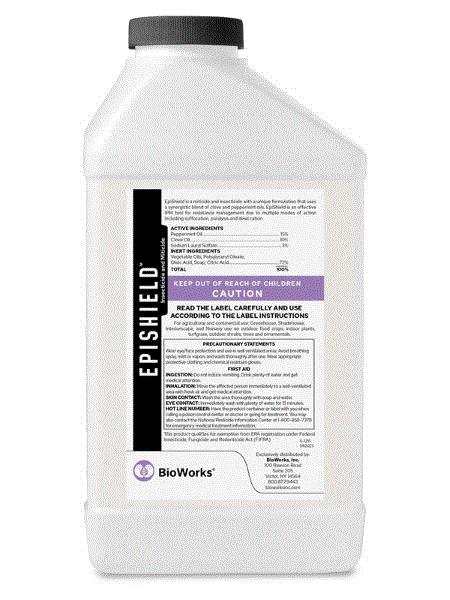
EpiShield can be applied as foliar spray at 9 to 12 fl. oz. per 100 gallons or as (rooted or unrooted) cutting dip at 0.09 fl. oz. (27 milliliter) per gallon. The spray application rates of EpiShield are 10 times lower than the typical horticultural oil application rates of 1% to 2%. EpiShield’s shelf life is one year when stored at room temperature (70 to 75F).
I worked with several botanical extract and essential oil products in the past few years. Crop safety is often an issue with essential oil products, but I found that to have greatly improved since about 10 years ago. EpiShield at the label rate has been shown to be safe for some finicky crops, such as begonia, fern, impatiens and roses.
EpiShield is currently available in all U.S. states except Florida, Iowa, Maryland and Washington. GO HERE to find more information about EpiShield, including efficacy and crop safety test results.

Webinar on Biologicals
There's been quite a bit of talk about using or incorporating beneficial organisms in potting media in the past few years. I don't know a whole lot about this topic. Do you? Are you kind of like me: not knowing if these beneficial microorganisms or biologicals can help with growing better plants in your operations?
Then join the next GrowerTalks webinar, Building Better Plants With Biologicals, to learn more about the benefits and use of biologicals in potting media. Nathan Wallace Springer of Premier Tech Horticulture will educate us on the features, benefits and practical uses of beneficial microorganisms, such as Bacillus pumilus and mycorrhizae.
The webinar is scheduled for Thursday, October 19 at 1:00 p.m. Eastern/Noon Central. You can register for the webinar HERE.
Caterpillar From Last Week
I showed y’all a picture of a Florida predatory stink bug feeding on a caterpillar last week. Remember that? Do you also remember that I said I didn’t know what the caterpillar was? Well, several of you wrote in, including Steve Compton, who's a retired plant pest specialist with Clemson University’s Department of Plant Industry and taught me something about identifying caterpillars. It’s great! I love to learn and know that folks are interested in bugs.
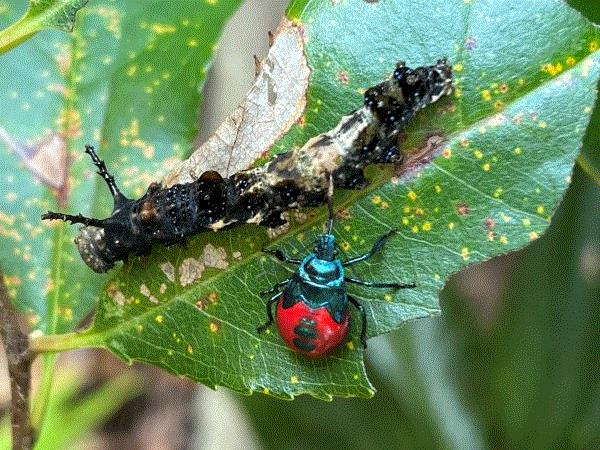
Steve called it the spiny humped caterpillar. You may not be familiar with this common name, but you’ll definitely know the name of the butterfly that would have developed from this caterpillar—Viceroy. The Viceroy and Admirals are a big group of butterflies, but the Viceroy (Limenitis archippus) is a pretty common species. There are five subspecies throughout North America, with the Eastern Viceroy (L. archippus subspecies archippus) being the most common one in my neck of the woods. This one was feeding on wild cherry when it was attacked by the predatory stink bug.
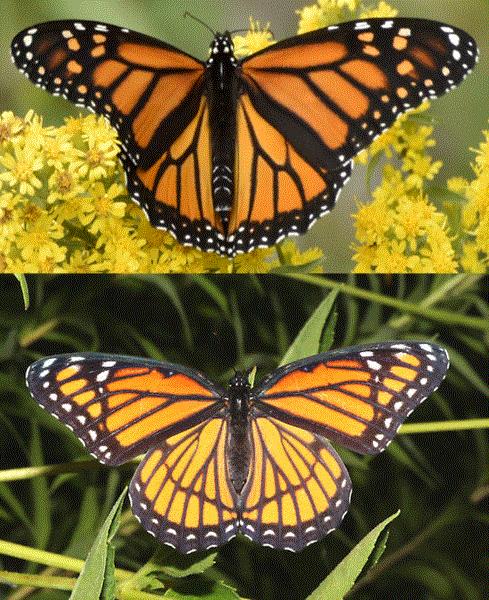
A Monarch (top) and a Viceroy (bottom). Can you tell them apart? (Photo credit: Siobhan Basile and MJ Hatfield on Bugguide.)
I see the Viceroys often, but I always have to do a double-take and ask if I’m seeing a Viceroy or a Monarch. That’s because the Eastern Viceroy mimics the Monarch (and the Florida Viceroy mimics the Queen). It’s believed for a long time that Viceroy, which was thought to be non-toxic and quite edible to a bird, mimics the toxic Monarch. It turns out the Eastern Viceroy is toxic on its own.
In a fun experiment (okay, maybe fun for us ecologists), David Ritland and Lincoln Brower of the University of Florida showed that birds learned quite quickly that both the Eastern Viceroy and the Monarch were totally nasty! I wonder what came across the mind of the bird that took the first bite of a Viceroy?
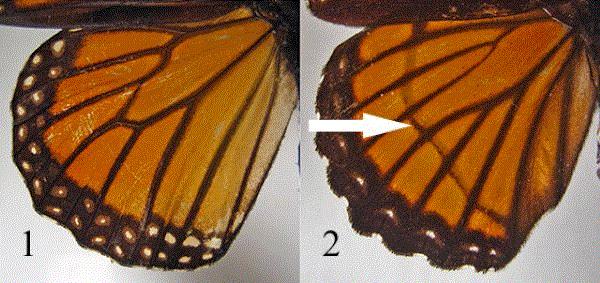
A comparison of the hindwing of a Monarch (1) and a Viceroy (2). (Photo credit: Christopher Wirth on Bugguide.)
At first glance, the Viceroy and the Monarch are hard to tell apart: Wings of both species have white dots and black lines over an orange background. Look closer at the two pictures above and you may be able to see a dark line across the hind wings of the Viceroy, but not the Monarch.
I’ll remember the spiny humped caterpillar from now on. That white saddle on its back is quite distinctive. Now, go out there and look for those Viceroys and Monarchs! If you live further north, I’m sorry—the Monarchs have already headed south to its overwintering ground in Mexico.




See y’all later!

JC Chong
Technical Development Manager at SePRO
Adjunct Professor at Clemson University
This e-mail received by 27,847 subscribers like you!
If you're interested in advertising on PestTalks contact Kim Brown ASAP!